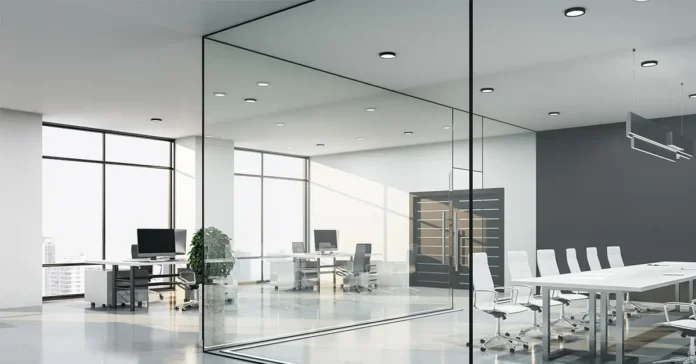From flexible layouts that promote creativity and innovation to sustainable practices that prioritize environmental responsibility, the future of office spaces is vibrant and diverse. Technology plays a crucial role, empowering teams to collaborate seamlessly across distances and enhancing productivity through smart automation.
As we step into the future, the way we work is undergoing a remarkable transformation. In this exploration, we will uncover the latest trends that are reshaping office spaces worldwide, making them more dynamic, collaborative, and adaptable than ever before.
Moreover, employee well-being is at the forefront, with designs focused on creating comfortable and inspiring work environments that promote health and happiness. Join us as we delve into these trends and transformations, offering insights and inspiration for creating the ideal office space of tomorrow. Businesses will need to reconsider their space design strategies considering the trend away from the traditional office.
Future of Office Spaces
According to a CBRE survey, the typical office size decreased from 727 square feet in 2010 to 595 square feet in 2016. Future offices may continue to get smaller in accordance with this trend, given the post-pandemic hybrid work environments. New reports suggest that half of the millennials want to work remotely at some point. The capacity to work remotely, in the opinion of over 60% of respondents, is necessary for maintaining a successful career, according to a Deloitte survey.
Consequently, what does this entail for offices? The following are the upcoming trends to watch out for in the future of office spaces.
1. Smaller Spaces
COVID-19 has moved our life to our laptops. Working remotely has its advantages. Employees no longer need to commute, for instance. Work can be done anywhere. This has created the need for smaller spaces.
However, one thing has been constant. People still require gathering spaces. Companies are rethinking their workspace to promote collaboration among employees. Smaller offices that are used rotationally for employees or for team brainstorms are the key trend.
2. More Open Plan Offices
Many businesses are converting enclosed facilities to open areas. These include “hot desks,” which means no fixed desks are allocated to employees. This also includes the need to include more meeting areas, collaboration spaces, and places where employees can engage with one another more informally. Open plan offices are designed to increase team bonding and increase speed as well as efficiency.
3. Fewer Walls
Cubicle days are numbered. The number of offices with open floor plans is increasing, which reduces wall space. Instead of staying cooped up behind their desks, workers are urged to mingle with one another. Virtual meetings are now more convenient than ever, thanks to the growth of video conferencing. You may even host a conference call on your smartphone. This means when employees come to the workplace, it is with the intention of interacting with one another.
4. Fewer Private Offices
Another related trend, therefore, is the reduction in private offices. Companies prefer to reduce private offices as they become more collaborative. Also, the reduction in hierarchical structures in organisations has led to more open-door policies. Only 20% of workers claimed they preferred working alone in a 2018 survey. That indicates that 80 per cent of them desired collaboration and access to their leadership.
5. More Flexible Workspaces
Office-based workers spend a lot of time in the physical office, so how you set up your workspace is crucial. There are many kinds of workspaces, however, it is frequently preferred to have a flexible arrangement that allows employees to choose from a variety of working environments.
Businesses are beginning to provide a variety of workspace possibilities. Some workplaces let employees choose the furniture style they want to utilise. Others allow them to bring their own devices, on a regular basis.
Self-storage units come in handy when office space-based workers are allowed to customise and choose their type of furniture. Furniture and other necessities can be stacked up in the storage space and then rotated whenever needed or as new employees join.
6. Hybrid Work Model
The term “hybrid work” describes situations in which some teams collaborate in person and others virtually. Companies may cut travel expenses, boost production, and save money with this kind of agreement. However, working in a hybrid environment has certain difficulties. How, for instance, do you ensure that everyone is cooperating productively? How do you make sure everyone is able to see what the other is working on? And how can you keep everyone interested all day long?
You can manage many projects at once, communicate in real-time across multiple locations, and schedule recurrent meetings with the help of a good collaboration system. These tools will enable your team members to collaborate successfully even if they are not physically there.
The top team collaboration tools give your team members access to the data they require to work effectively. You want to remove obstacles that stop members of your team from participating in meetings. They must have access to edit files, examine papers, and participate in discussions. They will not feel comfortable participating in meetings if they cannot.
Additionally, you want to guarantee that communication between team members is simple. The transition between meeting attendees and those who are not there must be smooth. The top collaboration tools let you simply plan repeating meetings and remind participants. By doing this, you may eliminate schedule issues and guarantee that everyone participates in every conversation.
Finally, you want to guarantee that everybody feels included. Meetings should be open to employees whenever they want to attend. They should not have to wait for an invitation from someone else. The greatest collaboration tools give you various choices so you can decide when and how frequently your team members can join meetings.
7. The office should be a destination, not a chore
Finally, the way we work now is affecting office design. We are interacting with co-workers in person more frequently and spend less time behind desks. This change forces us to reconsider the layout of our offices and the activities that take place there.
Open areas, collaboration spaces, meeting spaces, and lounges are replacing the conventional workplace layout. Because of these modifications, workplaces can now be built to promote employee connection and cooperation rather than having to resemble a manufacturing floor.
Final Words on Office Spaces
As we’ve explored the latest trends, from flexible layouts to sustainable practices and advanced technology integration, it’s clear that the future of office spaces is dynamic and promising. The journey has shown us that modern workplaces are not just about functionality but also about fostering creativity, collaboration, and employee well-being. By embracing these trends and transformations, organizations can create environments that inspire productivity, innovation, and a sense of belonging among their teams.
As we look ahead, it’s exciting to envision how these trends will continue to shape the way we work, offering new possibilities for businesses to thrive and for employees to flourish. Thank you for joining us on this exploration of the future of office spaces, and may your own workspace be a reflection of these positive changes to come.
FAQs for Office Spaces
A1: Key trends include flexible work arrangements, technology integration, sustainability initiatives, and wellness-focused designs.
A2: Technology is transforming office spaces through smart automation, virtual collaboration tools, IoT integration, and data-driven decision-making.
A3: Sustainability is becoming a priority with green building designs, energy-efficient systems, waste reduction strategies, and eco-friendly materials.
A4: Office layouts are evolving with open-plan designs, agile workstations, collaborative zones, and hybrid spaces for remote and in-office work.
A5: Remote work influences office space design with a focus on flexible layouts, hot-desking options, and creating a sense of community when employees are on-site.
A6: Companies are prioritizing employee well-being by incorporating natural light, green spaces, ergonomic furniture, wellness programs, and mental health support.
A7: Challenges include cost considerations, change management, technology integration issues, maintaining company culture, and addressing diverse employee needs.
A8: Office spaces can foster creativity and innovation through inspiring environments, designated brainstorming areas, collaboration hubs, and encouraging diverse perspectives.
A9: Flexibility is crucial for future office space design, allowing for adaptable layouts, modular furniture, agile workspaces, and accommodating changing business needs.
A10: Businesses can future-proof their office spaces by staying agile, investing in scalable technologies, gathering feedback from employees, and continuously evolving to meet evolving work trends.








